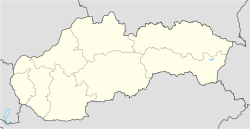Šahy
Šahy
Ipolyság | |
|---|---|
Town | |
 Guildhall | |
|
Coat of arms of Šahy Coat of arms | |
| Coordinates: 48°03′55″N 18°57′05″E / 48.06528°N 18.95139°E | |
| Land | Slowakei |
| Region | Nitra |
| District | Levice |
| First mentioned | 1237 |
| Regierung | |
| • Mayor | Ing. Štefan Gregor |
| Area | |
| • Total | 42.727 km2 (16.497 sq mi) |
| Elevation | 136 m (446 ft) |
| Population (2018-12-31[1]) | |
| • Total | 7,238 |
| • Density | 170/km2 (440/sq mi) |
| Time zone | UTC+1 (CET) |
| • Summer (DST) | UTC+2 (CEST) |
| Postal code | 936 01 |
| Area code | 421-36 |
| Car plate | LV |
| Website | http://www.sahy.sk |
Šahy (until 1927 "Ipolské Šiahy", Hungarian: Ipolyság, rarely German: Eipelschlag) is a town in southern Slovakia, The town has an ethnic Hungarian majority and its population is 7,238 people (2018), with an average age of 42.5.
Geography
It is located at the eastern reaches of the Danubian Lowland on the river Ipeľ at the Hungarian border, on the E77 road from Budapest to Kraków. Besides the main settlement, it also has two "boroughs" of Preseľany nad Ipľom (4 km (2.49 mi) west of centre, annexed 1980) and Tešmák (3 km (1.86 mi) east of centre, annexed 1986). From 1980 to 1996 it also had now independent village of Hrkovce.
History
The first written mention is from 1237 in a document of King Béla IV under name Saag, when Martin Hont-Pázmány founded a Premonstratensian monastery there. It got character of a small town in the 14th century. It was part of Ottoman Empire between 1541–1595 and 1605–1685 and was known as "Şefradi". It was also sanjak centre in Uyvar eyalet between 1663-1685. Before break-up of Austria-Hungary in 1918/1920 and incorporation into Czechoslovakia, it was part of the Hont County, and was from 1806 its capital. It was part of Hungary from 1938 to 1945 as a result of the First Vienna Award.
Demographics
According to the 2014 census, the town had 7,516 inhabitants. In 2001 62.21% of the inhabitants were Hungarians, 34.57% Slovaks, 0.56% Czech and 0.41 Roma.[2] The religious makeup was 84.06% Roman Catholics, 6.87% people with no religious affiliation, and 3.46% Lutherans.[2]
Facilities
The town is home to the Hont Museum and Gallery of Ľudovít Simony.[3]
Sister Cities
Notable people
- Ferdinand Daučík, football player and manager
- Branko Kubala, football player
- Ladislav Ballek, writer
References
- ^ "Population and migration". Statistical Office oftheSlovak Republic. Retrieved 2019-04-16.
- ^ a b "Municipal Statistics". Statistical Office of the Slovak republic. Archived from the original on 2007-12-17. Retrieved 2007-12-26.
- ^ Milan Paprčka; Simona Nádašiová (2016). Hont z neba. Banská Bystrica: CBS spol. ISBN 978-80-8144-109-7.

